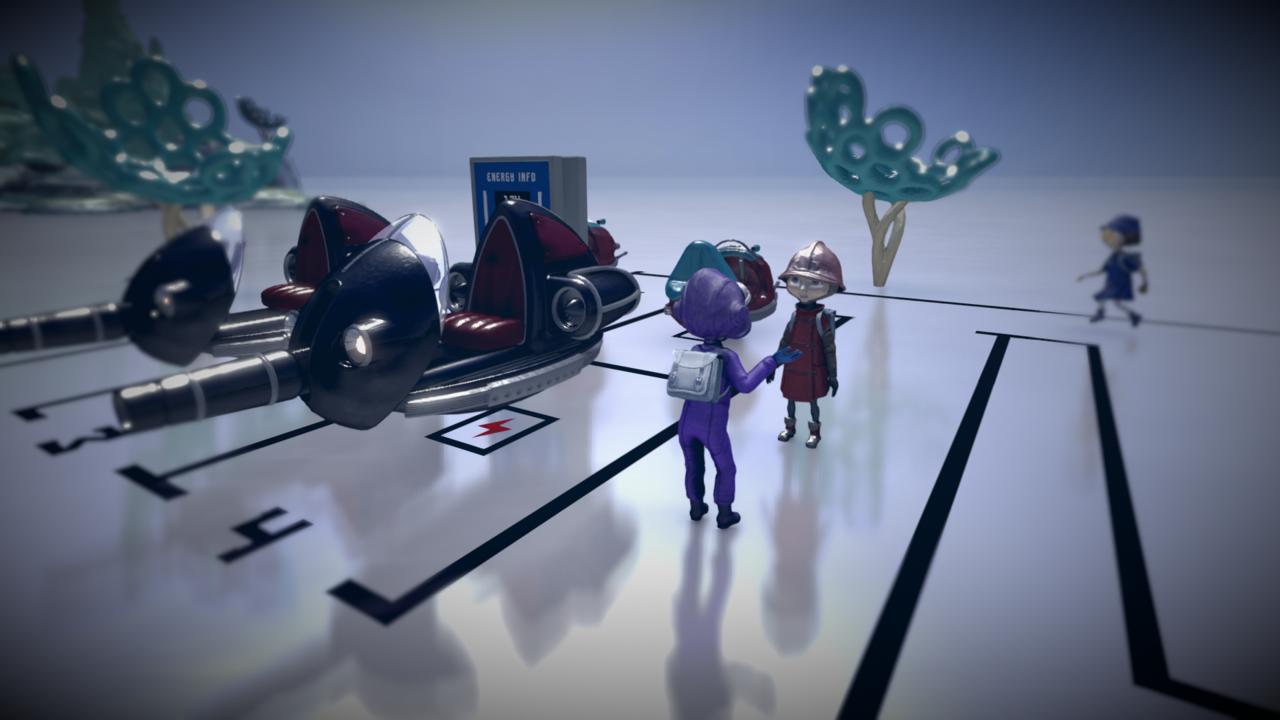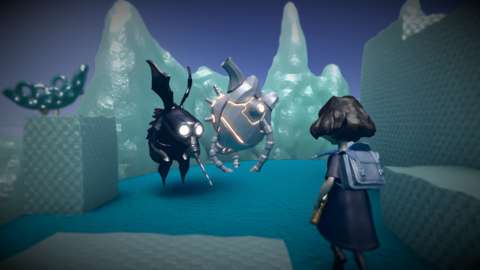Dylan Cuthbert's Q-Games has been a PlayStation mainstay for nearly a decade. Its PixelJunk games were consistently stylish, cohesive, and engaging. In a disappointing contrast, the studio's latest downloadable PlayStation-exclusive, The Tomorrow Children, is a bland, monotonous, inscrutable mess. Though difficult to categorize, the game consists primarily of resource gathering and city building, with some floaty platforming and clumsy combat filling the gaps in between. While that might sound a bit like Minecraft, the two games differ drastically in both their overall tone and their fundamental approach to gameplay.
Where Minecraft allows for and even incentivizes creativity, Tomorrow Children locks you into a tedious, time-draining loop that never amounts to a larger payoff. And worse still, it fails to explain many of its convoluted gameplay systems, leaving you to flounder for the first hour and periodically exclaim, "So that's what that's for?" every few hours after that.

The opening tutorial at least explains the absolute basics: Following a failed global experiment, all that remains of our world is The Void, a vast, empty space dotted with disconnected towns, a handful of marauding monsters, and resource-rich "islands" that randomly appear in the nothingness. Your character is one of an army of identical "projections" that serve as the worker drones of the Soviet-themed society.
And though the tutorial skips this part, each projection is controlled by another human player. For some reason, you'll only catch brief, ethereal glimpses of other players rather than simply playing alongside them at all times, but you'll feel their presence as your resource counts fluctuate and new buildings pop up in your shared town.
The tutorial also doesn't cover what you're supposed to do in Tomorrow Children, let alone how or why. As much as resource-gathering sounds like it would be self-evident, you're denied basic information like where to buy mining tools and how to reach islands so you can put those tools to use. Games aren't obligated to hold your hand, but Tomorrow Children isn't playing coy in service of some grander mystery like, say, The Witness. It just forces you to slog your way through early frustration for no discernable reason.
And once you fight through that fog of frustration, the game that comes into focus isn't any more welcoming. For example, resource-gathering constitutes the single largest portion of the moment-to-moment gameplay, but every single step in the process is excruciatingly tedious. First, you must travel from your town to the one currently available island. But you can't run there because projections sink through the quicksand-like floor of the Void.

Instead, you have to wait for the bus. You cannot call the bus; it runs on a preset schedule. So you have to wait. And there is only one bus. If you wander up as it's pulling away, too bad. You just have to wait for it to return, which will likely take a few minutes. And even once you board the bus, you can't skip the ride. If you hate unskippable cutscenes, imagine an unskippable bus ride through a blank white abyss.
You can eventually bribe your way into a vehicle licence (another poorly explained aspect of the game), but driving isn't much better. You no longer have to wait, but holding R2 as you cross a straight, flat surface is about as exciting as watching paint dry. If you're extremely lucky, the island will appear close enough to your town that you can conjure a bridge using a purchased "Void Power," but those situations are, sadly, quite rare.
Once you actually reach the island, you can start to break its odd, destructible environments down into resources. Unfortunately, you're at the mercy of your tools. See, the black market pickaxe you can purchase using real-world cash is, according to the menu text, 15.5 times faster than the basic pickaxe you can purchase using earned in-game currency. With the basic pickaxe, you hit a button once, then wait as your projection hammers away and a meter slowly fills. It's painful, especially considering all tools--even those for-purchase tools--break over time.
In fairness, the $20 Founders Pack version of the game (as opposed to the upcoming free-to-play edition) starts you with a moderate cash injection, and you'll discover cash randomly strewn around the world as well. But even with this bonus cash, your supply will inevitably run out, and when it does, you'll either have to endure some microtransactions or claw your eyes out in boredom since this is just one of the many, many instances where the game prompts you to spend real money to save time.
Regardless of what you use to mine for resources, you'll ultimately achieve the same end result: raw materials that you have to drag from their spot on the island back to the bus stop. The problem this time is your backpack: it contains just three pockets for resources, meaning you can only transport four chunks of material at time if you hold the fourth in your hands. This results in endless unavoidable backtracking that is utterly mindless and repetitive. You can eventually earn a fourth pocket, but needless to say, it doesn't help much.
Then, naturally, you have to wait for the bus to return before manually hauling all the resources from the return bus stop to their individual piles further into town--yet another tiresome, empty process that could have easily been automated. The islands themselves can be visually intriguing and even fun to explore, but that's nowhere near enough to compensate for the mind-numbing, time-devouring resource collection loop.
Of course, all that resource gathering is in service of the game's other major gameplay pillar: crafting. If the city-building portion of Tomorrow Children was brilliant and rewarding, maybe--just maybe--all that tedious mining and moving and piling would feel worthwhile. Unfortunately, it's not. At all. In spite its labyrinthine menus and the deluge of indecipherable town stats, there's actually not much depth or strategy to the building.
Basically every town you could possibly find yourself in will already have most of its essential infrastructure, so at best, you'll need to add a power plant or maybe a new apartment complex or a turret. The crafting table simply doesn't offer many options that are actually worth building, which stymies any strategy that might have emerged from this portion of the game. Plus, even if you know exactly what you need to build, there's a always a chance you won't be able to. Islands contain a random assortment of resources; more than once, I desperately needed metal but could only find crystal and coal. When that happened, I could only wait for the next island to spawn.

Even the act of crafting isn't enjoyable. Basically, you approach the town's lone crafting station and, assuming you have the requisite resources and that no other player is using the station at that time, select what you want to build from the preset menu (which does not seem to grow or change as you level up). At that point, you're forced to solve a tile-sliding puzzle. Oh, but don't worry, you can use your real-world cash to solve the puzzle instantly if you don't feel like pushing numbered tiles around a grid-based board until they all appear in numerical order.
Outside of crafting, town's also teem with civics-related stats and gameplay systems, including "elections" that allow players to buff different portions of the town's basic operations based on their chosen leader's platform. I was pretty flustered trying to understand all the nuances until I realized none of these ancillary systems had any material impact on my experience. Elections, leveling perks, my town's technology rating--their menus explained the numerical implications of each one, but I never actually felt that impact while playing the game.
I also never felt attached to my town in any way. Games like Minecraft and Stardew Valley allow you to develop a sense of ownership over your creations because your decisions directly shape every little detail. But remember, in Tomorrow Children, you're building a town with online strangers with whom you cannot communicate. As a result, town's develop haphazard layouts that are difficult to navigate much less take pride in.
Worse still, your individual contributions are sometimes rendered meaningless. For example, I once logged back into the game after just a few hours away, and when I returned to the town I'd been working on, I received a prompt that read: "The restoration of this town is complete." Apparently the other members of my town had done enough building and gathering to finish what we'd started together. Needless to say, getting booted back to a menu and being told to pick a new town didn't exactly fill me with a deep sense of accomplishment.
If nothing else, the game's Soviet style is certainly novel. From its creepy doll-faced characters to its patriotic propaganda, Tomorrow Children certainly makes the most of its chosen motif. Unfortunately, that motif is much cooler on paper than in practice. Propaganda is designed to beat you down and break your spirit, so it's no surprise being surrounding by it for hours at a time is actually pretty unpleasant. After hearing the same Soviet march blare at me from a teleprompter for the hundredth time, I was more than ready to leave that world forever. I simply did not want to spend time there.
It also didn't help that Tomorrow Children suffers from persistent, noticeable technical problems. Objects routinely clip through each other. In one instance, I saw two vehicles become entwined and rendered unusable. They just sat idling in a heap in the middle of town. At another point, I actually got trapped on a bus. I could swivel the camera into the back of my own head, but I couldn't actually disembark. And while this might have been a deliberate aesthetic choice, many objects in the world are so shiny they almost appear greasy. The lighting is impressive in many instances but rarely necessary.
Frankly, however, technical problems are the least of Tomorrow Children's troubles. The resource gathering is tedious, the crafting is superficial, town management is convoluted, microtransactions are practically inescapable, and the world is unwelcoming and empty. In short: The individual components aren't enjoyable, and they don't contribute to anything bigger. There is no payoff. There is no point.









